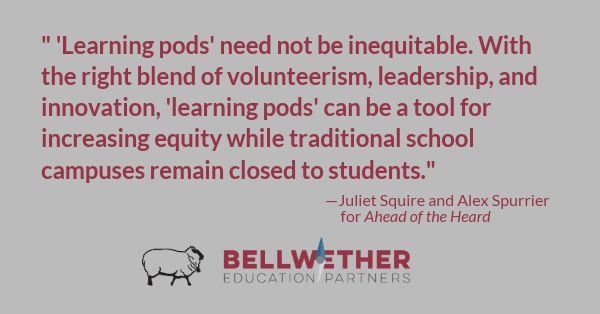Born out of desperation, families across the country are looking outside the school system for safe educational options for their children this fall, often partnering with other families to privately finance small-group learning. These “learning pods,” also referred to as “pandemic pods,” have fomented concerns about equity, since only a fraction of Americans can afford to pay a teacher out-of-pocket.
But “learning pods” need not be inequitable. With the right blend of volunteerism, leadership, and innovation, learning pods can be a tool for increasing equity while traditional school campuses remain closed to students.
Here’s how:
Ask community spaces to donate meeting facilities
The requirements of social distancing demand more space if all students are to get a full education. Meanwhile, there are churches, temples, community centers, office buildings, and storefronts across the country currently sitting empty, as large gatherings are discouraged, adults work from home, and retailers close up shop. Many of those entities would probably be willing to donate their space to small learning communities at no cost, or in exchange for financial relief on their rent or mortgage payments.
Expand the pool of potential teachers to enable lower student-teacher ratios
Student-to-teacher ratios are lower today than they were 30 or 40 years ago, but still higher than the number of students we might want to share a learning pod in order to minimize public health risks. According to the National Center for Education Statistics, the average number of students per teacher in 2017 was 16. Including the total number of instructional staff brings that ratio down significantly to 11.7. Add in teachers who have retired or left the profession, substitute teachers, students studying to become teachers, Americorps volunteers, and others and there may just be enough to create learning pods of 10 students or fewer. This could create the conditions for personalized instruction on a scale that’s often been dreamed of but never fully realized.
Provide high-quality teaching materials and supports
Families and educators — especially those working outside their usual roles — will need access to high-quality curricula, instructional materials, and supports. Research has demonstrated that choosing high-quality instructional materials can have a similar impact on student outcomes as efforts to improve educator quality. States could follow Louisiana’s example by identifying curricula and learning materials that meet a certain standard. Districts could also make widely available the trainings they rolled out this spring to support teachers’ transitions to distance learning, and teacher training programs could offer bootcamps (like Teach for America’s virtual summer institute) to help get others up to speed.
Thoughtfully match family demand to teacher supply
Families and teachers need a way to match needs and preferences beyond relying solely on personal networks to group students together. Several organizations are already trying to meet this need: Selected for Families, Friendly Minds, and Learning Pods all offer families support in starting their own pods. But to equalize access for all families, something more akin to a unified enrollment system would make sense. In cities like Washington, DC, New Orleans, and Denver, unified enrollment systems have helped coordinate robust choice marketplaces, using theories and algorithms developed by Nobel-prize winning economists to streamline and maximize the matching process between families and schools according to school capacity and family preferences. A similar mechanism could connect families to individual teachers, while accounting for health conditions and risk preferences.
Fund access for all families
Policymakers must find a way to ensure the cost of learning pods is not a barrier for middle- and low-income families. Free-market proponents have suggested that vouchers and education savings accounts have enormous potential to provide flexible funding to families to pursue learning options outside of the traditional system. But this is not the only option. For instance, many private schools use a sliding scale for tuition, with family tuitions at the high end of the spectrum subsidizing those at the other. Privately funded scholarships (through tax-credit scholarship programs or otherwise) are also an option. And there’s no reason that district school systems can’t be part of the learning pod solution. What’s to say that individual teachers could not be employed and paid by the district while providing instruction to a small group of students in an off-campus location?
Supporting children’s safety, development, and education through the pandemic is daunting. There are practical, contractual, and regulatory constraints that limit the opportunity for learning pods to serve students at scale. Overcoming these challenges will require extraordinary voluntarism, leadership, and innovation. But it is possible. From the Rosenwald Schools in the early 20th century to the Freedom Schools of the Civil Rights era, our nation has a rich history of parents, educators, and civic-minded leaders developing solutions for children not being served well by the school system. It’s time for leaders to put politics aside and work together to ensure students continue to learn and thrive for as long as the pandemic continues.
July 29, 2020
5 Recommendations to Make “Learning Pods” More Equitable
By Bellwether

Share this article